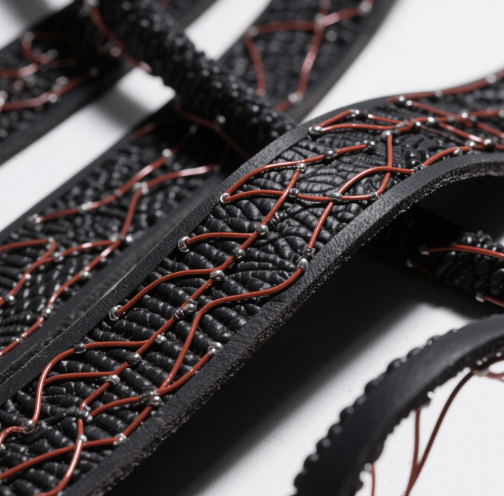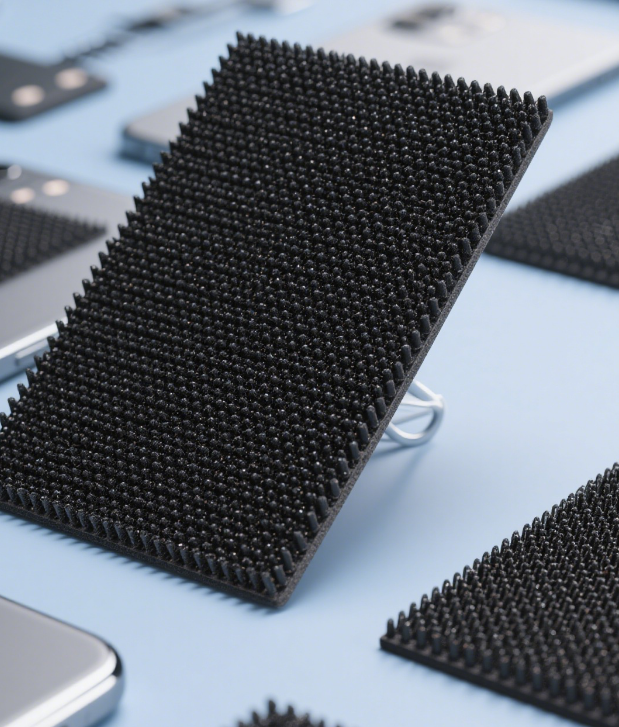conductive rubber of multifunctional composite materials
Multifunctional composite conductive rubber is an intelligent material that integrates electrical conductivity, mechanical properties, and environmental adaptability. By introducing conductive fillers (such as metal particles and carbon nanomaterials) into the rubber matrix and conducting functionalized structural design, it achieves multiple characteristics that are difficult to possess for a single material. The following provides a detailed analysis from aspects such as material composition, preparation technology, performance characteristics, application fields, and cutting – edge progress:
I. Material Composition and Classification
1. Matrix Materials
- Silicone rubber: It can withstand high temperatures (-60°C to 200°C) and has strong weather resistance, which is widely used for sealing electronic devices.
- Nitrile rubber: It is resistant to oil and chemical corrosion and is suitable for the automotive industry.
- Fluororubber: It can withstand extreme temperatures (-40°C to 280°C) and highly corrosive environments and is used in aerospace.
2. Conductive Fillers
| Filler Type | Typical Materials | Performance Characteristics |
| Metal – based | Silver, silver – plated copper, nickel – coated copper powder | High electrical conductivity (volume resistivity of 0.002 – 0.1 Ω・cm), but prone to oxidation (copper, aluminum). |
| Carbon – based | Carbon black, graphene, carbon nanotubes | Low cost, low density, and adjustable electrical conductivity (10² – 10⁹ Ω・cm), but require a high filling amount. |
| Composite fillers | Silver/glass microbeads, nickel/graphite | Combine electrical conductivity and economy. For example, the cost of nickel – coated copper powder is 50% lower than that of pure silver, and it has excellent oxidation resistance. |
3. Functional Additives
- Coupling agents: Enhance the interfacial bonding between the filler and the matrix and improve the salt – spray resistance (such as silane coupling agents).
- Vulcanizing agents: Improve the permanent compression set at high temperatures (such as peroxide vulcanization systems).
- Nanomaterials: Improve thermal conductivity and electromagnetic shielding performance.
II. Preparation Technology and Innovation
1. Traditional Methods
- Mixing and vulcanization: Mix the filler with rubber in an open mill and form a conductive network through vulcanization. For example, carbon – black – filled silicone rubber needs to add 10 – 30 phr of carbon black to reach the electrical conductivity threshold.
- Solution blending: Suitable for nano – fillers (such as graphene), dry and form after ultrasonic dispersion, but there is a problem of solvent residue.
2. Cutting – Edge Technologies
- In – situ polymerization: Directly grow conductive fillers (such as silver nanoparticles) in the rubber matrix to form a uniform conductive network.
- 3D printing: Use digital light processing (DLP) technology to manufacture complex structures, such as lattice – type conductive rubber for flexible sensors.
- Self – repair design: Introduce dynamic covalent bonds (such as disulfide bonds) or micro – capsule repair agents to achieve self – repair after damage.
3. Structural Design
- Gradient structure: Such as the “zebra strip” with alternating conductive and insulating layers, used for connecting liquid crystal displays.
- Porous structure: Carbon – black/polyurethane foam with micro – crack design reconstructs the conductive network when compressed, improving the pressure – sensing sensitivity.
III. Performance Characteristics and Applications
1. Core Performance
- Electrical conductivity: The volume resistivity can be as low as 0.002 Ω・cm (for pure silver fillers), meeting the requirements of electromagnetic shielding (≥120 dB) and electrostatic protection.
- Mechanical properties: Tensile strength of 2 – 10 MPa and elongation at break of 50% – 1200%.
- Environmental stability: Resistant to ultraviolet rays, ozone, and salt spray (such as silver – plated aluminum rubber has excellent salt – spray resistance).
2. Typical Applications
| Field | Specific Scenarios | Material Selection and Performance Requirements |
| Electronics | Electromagnetic shielding for mobile phones and laptops | Silver – plated aluminum silicone rubber, shielding effectiveness of 120 dB (at 10 GHz), permanent compression set ≤32%. |
| Automotive | Sensors and battery connections | Nitrile rubber filled with nickel – coated copper powder, conductivity of 0.004 Ω・cm, resistant to oil corrosion. |
| Aerospace | Satellite antennas and aircraft sealing | Fluororubber – based conductive materials, temperature resistance from – 60°C to 280°C, volume resistivity ≤0.1 Ω・cm. |
| Medical | Wearable health monitoring devices | Graphene/silicone rubber composite materials, tensile strain sensitivity GF = 5.2, excellent biocompatibility. |
| Energy | Solid – state battery electrolytes | Rubber – based organic polymer electrolytes, ionic conductivity of 10⁻⁴ S/cm, inhibiting the growth of lithium dendrites. |
3. Emerging Applications
- Smart infrastructure: Nano – conductive rubber pressure sensors are used for health monitoring of bridge bearings, with a measuring range of 0 – 40 MPa and an accuracy of ±4%.
- Flexible electronics: Super – hydrophobic conductive rubber (contact angle > 150°) works stably in a humid environment and is used for marine sensors.
- New energy: Stretchable solar cells (still maintain 19% photoelectric efficiency when stretched by 40%), a composite of conductive polymers and rubber.
IV. Challenges and Cutting – Edge Progress
1. Technical Bottlenecks
- Filler dispersion: Nano – fillers are prone to agglomeration, which needs to be improved through surface modification (such as dopamine coating) or dynamic cross – linked networks.
- Cost control: Metal fillers (such as silver) are expensive, and low – cost substitutes (such as nickel – coated copper powder) need to be developed.
- Environmental adaptability: Rubber hardens at extreme temperatures, and glass – transition temperature regulation technology (such as hydrogenated nitrile rubber) needs to be introduced.
V. Typical Cases
1. FIP Conductive Rubber
- Technology: Form – In – Place, which cures fluid rubber on complex surfaces through a dispensing device.
- Application: Sealing gaps in electronic devices, shielding effectiveness of 120 dB, compression ratio of 20% – 60%.
2. Super – Hydrophobic Conductive Rubber
- Preparation: Composite silver nanoparticles with rubber foam to form a porous and rough surface structure.
- Performance: Contact angle > 150°, conductivity of 10³ S/m, suitable for sensors in a humid environment.
3. Carbonized Melamine Sponge/Copper Composite Rubber
- Structure: A three – dimensional porous skeleton coated with a copper layer to improve electrical conductivity stability.
- Performance: Volume resistivity of 0.01 Ω・cm, tensile strength of 5 MPa, used for battery electrodes.
VI. Summary and Outlook
Through material design and structural innovation, multifunctional composite conductive rubber has achieved the coordinated optimization of electrical conductivity, mechanical properties, and environmental adaptability, showing great potential in fields such as electronics, energy, and medical. Future development directions include:
- Greenization: Application of bio – based rubber and degradable fillers.
- Intelligentization: Integration of functions such as self – repair and shape memory.
- Extreme environmental adaptability: Development of special rubbers resistant to ultra – high temperatures and strong radiation.
- Industrialization: Reducing costs and promoting large – scale production and application.
















